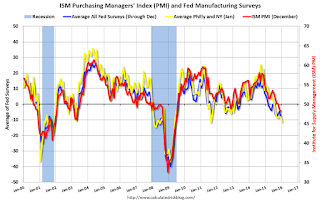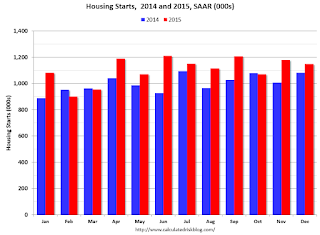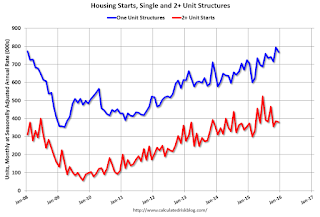by Calculated Risk on 1/21/2016 09:01:00 AM
Thursday, January 21, 2016
Philly Fed Manufacturing Survey showed "modest" contraction in January
From the Philly Fed: January 2016 Manufacturing Business Outlook Survey
Manufacturing conditions in the region contracted modestly this month, according to firms responding to the January Manufacturing Business Outlook Survey. The indicator for general activity remained negative this month; however, it rebounded from a lower reading in December.This was close to the consensus forecast of a reading of -4.0 for January.
...
The diffusion index for current activity increased from a revised reading of -10.2 in December to -3.5 and has now been negative for five consecutive months ...
The survey’s labor market indicators suggest weaker employment. The employment index decreased 4 points, from 2.2 to -1.9.
emphasis added
 Click on graph for larger image.
Click on graph for larger image.Here is a graph comparing the regional Fed surveys and the ISM manufacturing index. The yellow line is an average of the NY Fed (Empire State) and Philly Fed surveys through January. The ISM and total Fed surveys are through December.
The average of the Empire State and Philly Fed surveys decreased in January, and was solidly negative. This suggests another weak reading for the ISM survey.
Weekly Initial Unemployment Claims increase to 293,000
by Calculated Risk on 1/21/2016 08:34:00 AM
The DOL reported:
In the week ending January 16, the advance figure for seasonally adjusted initial claims was 293,000, an increase of 10,000 from the previous week's revised level. The previous week's level was revised down by 1,000 from 284,000 to 283,000. The 4-week moving average was 285,000, an increase of 6,500 from the previous week's revised average. The previous week's average was revised down by 250 from 278,750 to 278,500.The previous week was revised down to 283,000.
There were no special factors impacting this week's initial claims.
The following graph shows the 4-week moving average of weekly claims since 1971.
 Click on graph for larger image.
Click on graph for larger image.The dashed line on the graph is the current 4-week average. The four-week average of weekly unemployment claims increased to 285,000.
This was above the consensus forecast of 275,000. Although initial claims have increased recently, this is still a very low level and the 4-week average suggests few layoffs.
Wednesday, January 20, 2016
Thursday: Unemployment Claims, Philly Fed Mfg Survey
by Calculated Risk on 1/20/2016 06:58:00 PM
From Matthew Graham at Mortgage News Daily: Rates Head Back Toward Long Term Lows
Mortgage rates fell today, bringing them back in line with the lowest levels in more than 2 months and very near the best levels since late April 2015. ... The average lender is easily back into the "high 3's" when it comes to conventional 30yr fixed quotes for top tier scenarios. The only question is whether that means 3.75% or 3.875%. With today's improvements, quite a few lenders moved back down to to 3.75%. They don't necessarily represent a majority just yet, but it's getting to be a closer call.Thursday:
• At 8:30 AM, the initial weekly unemployment claims report will be released. The consensus is for 275 thousand initial claims, down from 284 thousand the previous week.
• At 8:30 AM, the Philly Fed manufacturing survey for January. The consensus is for a reading of -4.0, up from -5.9.
AIA: "Architecture Billings Index Ends Year on Positive Note"
by Calculated Risk on 1/20/2016 03:11:00 PM
Note: This index is a leading indicator primarily for new Commercial Real Estate (CRE) investment.
From the AIA: Architecture Billings Index Ends Year on Positive Note
There were a few occasions where demand for design services decreased from a month-to-month basis in 2015, but the Architecture Billings Index (ABI) concluded the year in positive terrain and was so in eight of the twelve months of the year. As a leading economic indicator of construction activity, the ABI reflects the approximate nine to twelve month lead time between architecture billings and construction spending. The American Institute of Architects (AIA) reported the December ABI score was 50.9, up from the mark of 49.3 in the previous month. This score reflects a slight increase in design services (any score above 50 indicates an increase in billings). The new projects inquiry index was 60.2, up from a reading of 58.6 the previous month.
“As has been the case for the past several years, there continues to be a mix of business conditions that architecture firms are experiencing,” said AIA Chief Economist Kermit Baker, Hon. AIA, PhD. “Overall, however, ABI scores for 2015 averaged just below the strong showing in 2014, which points to another healthy year for construction this year.”
...
• Regional averages: West (53.7), South (53.3), Northeast (46.7), Midwest (46.1)
• Sector index breakdown: multi-family residential (52.9), institutional (52.2), commercial / industrial (47.3), mixed practice (46.5)
emphasis added
 Click on graph for larger image.
Click on graph for larger image.This graph shows the Architecture Billings Index since 1996. The index was at 50.9 in December, down from 49.3 in November. Anything above 50 indicates expansion in demand for architects' services.
Note: This includes commercial and industrial facilities like hotels and office buildings, multi-family residential, as well as schools, hospitals and other institutions.
The multi-family residential market was negative for most of the year - suggesting a slowdown or less growth for apartments - but has been positive for the last three months.
According to the AIA, there is an "approximate nine to twelve month lag time between architecture billings and construction spending" on non-residential construction. This index was positive in 8 of the last 12 months, suggesting a further increase in CRE investment in 2016.
Key Measures Show Inflation close to 2% in December
by Calculated Risk on 1/20/2016 11:47:00 AM
The Cleveland Fed released the median CPI and the trimmed-mean CPI this morning:
According to the Federal Reserve Bank of Cleveland, the median Consumer Price Index rose 0.1% (1.8% annualized rate) in December. The 16% trimmed-mean Consumer Price Index also rose 0.1% (0.8% annualized rate) during the month. The median CPI and 16% trimmed-mean CPI are measures of core inflation calculated by the Federal Reserve Bank of Cleveland based on data released in the Bureau of Labor Statistics' (BLS) monthly CPI report.Note: The Cleveland Fed has the median CPI details for December here. Motor fuel was down 38% annualized in December.
Earlier today, the BLS reported that the seasonally adjusted CPI for all urban consumers fell 0.1% (-1.3% annualized rate) in December. The CPI less food and energy rose 0.1% (1.5% annualized rate) on a seasonally adjusted basis.
 Click on graph for larger image.
Click on graph for larger image.This graph shows the year-over-year change for these four key measures of inflation. On a year-over-year basis, the median CPI rose 2.4%, the trimmed-mean CPI rose 1.8%, and the CPI less food and energy also rose 2.1%. Core PCE is for November and increased 1.3% year-over-year.
On a monthly basis, median CPI was at 1.8% annualized, trimmed-mean CPI was at 0.8% annualized, and core CPI was at 1.5% annualized.
On a year-over-year basis, two of these measures suggest inflation remains below the Fed's target of 2%, and two measures, core CPI and median CPI, are above 2%.
Using these measures, inflation has been mostly moving up, and three of the measures are close to the Fed's target (Core PCE is still way below).
Comments on December Housing Starts
by Calculated Risk on 1/20/2016 10:11:00 AM
Earlier: Housing Starts declined to 1.149 Million Annual Rate in December
Total starts were up 10.8% in 2015 compared to 2014. My guess was for an increase of 8% to 12%.
Here is a table showing 1 unit and 5+ unit housing starts since the peak year in 2005. This also shows the year-over-year change for both categories. Single family starts were up 10.4% in 2015 compared to 2014. Starts for 5+ units were up 12.5% compared to 2014.
Note that the year-over-year change for 5+ units is smaller in 2015, and will probably be even smaller in 2016. Last year, after the June data was released, I pointed out that that might be the peak for the cycle (524 thousand SAAR in June 2015). I expect multi-family starts to move more sideways going forward.
| Starts and YOY % Change | ||||
|---|---|---|---|---|
| Year | 1 unit | % Change | 5+ units | % Change |
| 2005 | 1,715.8 | 6.5% | 311.4 | 2.8% |
| 2006 | 1,465.4 | -14.6% | 292.8 | -6.0% |
| 2007 | 1,046.0 | -28.6% | 277.3 | -5.3% |
| 2008 | 622.0 | -40.5% | 266.0 | -4.1% |
| 2009 | 445.1 | -28.4% | 97.3 | -63.4% |
| 2010 | 471.2 | 5.9% | 104.3 | 7.2% |
| 2011 | 430.6 | -8.6% | 167.3 | 60.4% |
| 2012 | 535.3 | 24.3% | 233.9 | 39.8% |
| 2013 | 617.6 | 15.4% | 293.7 | 25.6% |
| 2014 | 647.9 | 4.9% | 341.7 | 16.3% |
| 2015 | 715.3 | 10.4% | 384.4 | 12.5% |
 This first graph shows the month to month comparison between 2014 (blue) and 2015 (red).
This first graph shows the month to month comparison between 2014 (blue) and 2015 (red).Starts were up year-over-year in 9 of 12 months in 2015. The year started slow - weather impacted starts in February and March - but overall growth was about as expected.
Below is an update to the graph comparing multi-family starts and completions. Since it usually takes over a year on average to complete a multi-family project, there is a lag between multi-family starts and completions. Completions are important because that is new supply added to the market, and starts are important because that is future new supply (units under construction is also important for employment).
These graphs use a 12 month rolling total for NSA starts and completions.
 The blue line is for multifamily starts and the red line is for multifamily completions.
The blue line is for multifamily starts and the red line is for multifamily completions. The rolling 12 month total for starts (blue line) increased steadily over the last few years, and completions (red line) have lagged behind - but completions have been catching up (more deliveries), and will continue to follow starts up (completions lag starts by about 12 months).
Multi-family completions are increasing sharply year-over-year.
I think most of the growth in multi-family starts is probably behind us - in fact multi-family starts might have peaked in June (at 524 thousand SAAR) - although I expect solid multi-family starts for a few more years (based on demographics).
 The second graph shows single family starts and completions. It usually only takes about 6 months between starting a single family home and completion - so the lines are much closer. The blue line is for single family starts and the red line is for single family completions.
The second graph shows single family starts and completions. It usually only takes about 6 months between starting a single family home and completion - so the lines are much closer. The blue line is for single family starts and the red line is for single family completions.Note the exceptionally low level of single family starts and completions. The "wide bottom" was what I was forecasting several years ago, and now I expect several years of increasing single family starts and completions.
The housing recovery continues, but I expect less growth from multi-family going forward.
Housing Starts declined to 1.149 Million Annual Rate in December
by Calculated Risk on 1/20/2016 08:30:00 AM
From the Census Bureau: Permits, Starts and Completions
Housing Starts:
Privately-owned housing starts in December were at a seasonally adjusted annual rate of 1,149,000. This is 2.5 percent below the revised November estimate of 1,179,000, but is 6.4 percent above the December 2014 rate of 1,080,000.
Single-family housing starts in December were at a rate of 768,000; this is 3.3 percent below the revised November figure of 794,000. The December rate for units in buildings with five units or more was 365,000.
An estimated 1,111,200 housing units were started in 2015. This is 10.8 percent above the 2014 figure of 1,003,300.
Building Permits:
Privately-owned housing units authorized by building permits in December were at a seasonally adjusted annual rate of 1,232,000. This is 3.9 percent below the revised November rate of 1,282,000, but is 14.4 percent above the December 2014 estimate of 1,077,000.
Single-family authorizations in December were at a rate of 740,000; this is 1.8 percent above the revised November figure of 727,000. Authorizations of units in buildings with five units or more were at a rate of 455,000 in December.
emphasis added
 Click on graph for larger image.
Click on graph for larger image.The first graph shows single and multi-family housing starts for the last several years.
Multi-family starts (red, 2+ units) decreased in December. Multi-family starts are up 6% year-over-year.
Single-family starts (blue) decreased in December and are up 7% year-over-year.
 The second graph shows total and single unit starts since 1968.
The second graph shows total and single unit starts since 1968. The second graph shows the huge collapse following the housing bubble, and then - after moving sideways for a couple of years - housing is now recovering (but still historically low),
Total housing starts in December were below expectations, however starts for October and November were revised up. And starts were up 10.8% in 2015 compared to 2014. I'll have more later ...
MBA: Mortgage Applications Increased in Latest Weekly Survey, Purchase Applications up 17% YoY
by Calculated Risk on 1/20/2016 07:01:00 AM
From the MBA: Refinance Mortgage Applications Increase as Rates Fall in Latest MBA Weekly Survey
Mortgage applications increased 9.0 percent from one week earlier, according to data from the Mortgage Bankers Association’s (MBA) Weekly Mortgage Applications Survey for the week ending January 15, 2016.
...
The Refinance Index increased 19 percent from the previous week. The seasonally adjusted Purchase Index decreased 2 percent from one week earlier. The unadjusted Purchase Index increased 4 percent compared with the previous week and was 17 percent higher than the same week one year ago.
...
The average contract interest rate for 30-year fixed-rate mortgages with conforming loan balances ($417,000 or less) decreased to its lowest level since October 2015, 4.06 percent, from 4.12 percent, with points increasing to 0.41 from 0.38 (including the origination fee) for 80 percent loan-to-value ratio (LTV) loans.
emphasis added
 Click on graph for larger image.
Click on graph for larger image.The first graph shows the refinance index since 1990.
Refinance activity was higher in 2015 than in 2014, but it was still the third lowest year since 2000.
Refinance activity will probably stay low in 2016.
 The second graph shows the MBA mortgage purchase index.
The second graph shows the MBA mortgage purchase index. According to the MBA, the unadjusted purchase index is 17% higher than a year ago.
Tuesday, January 19, 2016
Wednesday: CPI, Housing Starts
by Calculated Risk on 1/19/2016 08:04:00 PM
An update on the rain in California ... from the LA Times: What happened to El Niño? Be patient, L.A., it'll come, expert says
[M]uch of the rain Northern California has received in recent months is not significantly related to El Niño. Most of that precipitation — including this week's storms hitting San Francisco — is coming from the typical winter weather pattern in California: cold storms from the northern Pacific Ocean, coming northwest of the state.Wednesday:
...
Experts say it's possible that the classic El Niño-influenced pattern could emerge by late January or early February. That would put it more in line with how the most punishing series of storms arrived in February 1998 and March of 1983.
"As we look back, the big show is usually in February, March — even into April and May," [NASA Jet Propulsion Laboratory climatologist] Patzert said. "So, in many ways, this is on schedule."
• At 7:00 AM ET, the Mortgage Bankers Association (MBA) will release the results for the mortgage purchase applications index.
• At 8:30 AM, the Consumer Price Index for December from the BLS. The consensus is for no change in CPI, and a 0.2% increase in core CPI.
• Also at 8:30 AM, Housing Starts for December. The consensus is for 1.198 million SAAR, up from 1.173 million in November.
• During the day: The AIA's Architecture Billings Index for December (a leading indicator for commercial real estate).
Mortgage News Daily: "Lenders quoting 30yr fixed rates of 3.875% on top tier scenarios"
by Calculated Risk on 1/19/2016 05:37:00 PM
Mortgage rates are nears the lows of the last two months ...
From Matthew Graham at Mortgage News Daily: Mortgage Rates Back Away From Long Term Lows
Mortgage rates moved higher today, but remained near the lowest levels in more than 2 months. Friday's drop was uncharacteristically sharp and put rates in a position to break 7 month lows had today gone the other direction. Most lenders are quoting conventional 30yr fixed rates of 3.875% on top tier scenarios. 4.0% is the next most prevalent quote with only a select few of the most aggressive lenders down at 3.75%. All of these assume top tier scenarios.Here is a table from Mortgage News Daily:
emphasis added


